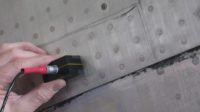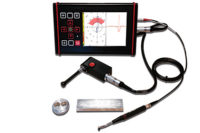NDT | Eddy Current
The History and Theory of Eddy Current Inspection
Compared to the other NDT disciplines, many would say that eddy current inspection is the least used as well as the most difficult to comprehend.

Image Source: BC Dushmantha / iStock / Getty Images
Within the industry, eddy current inspection is one of the five primary methods of NDT; the other disciplines being liquid penetrant, magnetic particle, ultrasonic and radiographic. Compared to the other disciplines, many would say that eddy current inspection is the least used as well as the most difficult to comprehend due to the abstract nature of the theory that undergirds the method. Those unfamiliar with the technology sometimes refer to it as a “black box inspection.” The history of eddy currents as well as the physics that enable the phenomenon is worthy of consideration in order to demystify this valuable method of inspection.
In the 19th century, scientific investigators documented most of what is known about magnetism and electromagnetism. During the period from 1775 to about 1900, scientific experimenters such as Coulomb, Ampere, Faraday, Oersted, Arago, Maxwell and Kelvin investigated the many facets of magnetism and electromagnetism. Hans Oersted in 1820 noted that current flow in a wire caused a force to act on a magnet (compass needle) near the wire. The reason is that movement of electric charge generates a magnetic field, so an electric current is surrounded by magnetic lines of induction. An electromagnet is a practical example. No magnetic field exists until the current is turned on.
In 1824, French scientist François Arago discovered that the oscillation of a magnet was rapidly damped when a non-magnetic conducting disk was placed near the magnet. He also observed that by rotating the disk, the magnet was attracted to the disk. In effect, Arago had introduced a varying magnetic field into the disk. This caused eddy currents to flow in the disk producing a magnetic field in the disk that opposed and coupled itself to the magnet. This simple model is the basis for analog automobile speedometers that were commonly used in the last century. This experiment can be easily duplicated today by dropping a strong rare earth disc shaped magnet down a copper tube with a high fill factor. The moving magnet will induce eddy currents within the copper tube that will oppose the primary field of the magnet. The resultant magnetic coupling will significantly slow the movement of the magnet through the nonferrous tube.
Eddy current testing is based primarily on the English scientist Michael Faraday’s discovery of electromagnetic induction in 1831. Faraday discovered that when a magnetic field passes through a conductor (a material in which electrons move easily), or when a conductor passes through a magnetic field, an electric current will flow through the conductor if there is a closed path through which the current can circulate. In 1879, another breakthrough was made when another English scientist, David Hughes, demonstrated how the properties of a coil change when placed in contact with metals of different conductivity and permeability.
In 1851, French physicist Leon Foucault built a device that used a copper disk moving in a strong magnetic field to show that eddy currents (magnetic fields) are generated when a material moves within an applied magnetic field. In September of 1855, he discovered that the force required for the rotation of a copper disc becomes greater when it is made to rotate with its rim between the poles of a magnet, the disc at the same time becoming heated by the eddy currents or “Foucault currents” induced in the metal.
In 1881, President Garfield lay dying of an assassin’s bullet. His personal doctor, Dr. Bliss, had to remove the bullet to save his life. He was unable to operate because the exact position of the bullet could not be determined. Apprised of this situation, Alexander Graham Bell invented an eddy current metal detector, using a balanced coil system. This detector would make a click in a telephone receiver when a probe coil was brought near the bullet. The device worked but failed to save Garfield’s life. Dr. Bliss did not honor Graham’s instructions to remove Garfield from his bed. The steel springs of the bed caused a nonrelevant continuous signal in the instrument. This perhaps was the first of many failed eddy current inspections due to ignoring the work instructions.
In 1933, Professor Friedrich Förster of Germany adapted eddy current technology to industrial use, developing instruments for measuring conductivity and for sorting mixed-up ferrous components. A delightful resource for electromagnetism is “Magnaflux Corporation: A History” which documents the years of the company between 1929 to 1979. This book recounts that in the 1940s, Dr. Förster came from Germany to seek a collaborator for production of eddy current machines in America. Under the supervision of Glenn McClurg (the author of the magnetic particle coil low fill factor formula), this collaboration with Magnaflux led to the introduction of the FM-100, the first popular conductivity meter. In the 1950s, another result of this collaboration was the ED-500, the first popular impedance eddy current meter. This meter was identified with a prefix of ED, after its developer, Ed Eul. This meter was picked up by various aerospace manufacturers such as Boeing in Wichita, KS, who used it to inspect most the bolt holes of the 467 B52 bomber that were manufactured there.
Although impedance meters are still in use today, impedance plane instruments were popularized in the 1960s. These ocilloscope instruments, rather than display a meter needle movement up or down indicating a variation in impedance, were able to present a display wherein variations in electrical conductivity could be distinguished from magnetic variables. In September of 1971, at the annual ATA NDT Forum, K. Mike King, a Nortec eddy current applications engineer, released the groundbreaking paper, “Why Not Use All the Information?” This paper detailed the advantages of “phase analysis” or impedance plane instruments over metered instruments. Whereas impedance meters provide one channel of information, impedance plane instruments can differentiate between both phase and amplitude variables. Today’s digital display impedance plane instruments have replaced the 1970s oscilloscope units.
The following statements summarize the eddy current inspection process. In eddy current testing, an alternating current is applied to a copper coil, which generates a magnetic field (Oersted’s discovery) in and around that coil (also known as the eddy current probe). When the coil is placed close to a conductive material (test part), the magnetic field from the coil will create an alternating current in the material (Faraday’s Law). These induced currents are in the form of circular loops known as eddy currents. The eddy currents flowing through the material create an opposing magnetic field (Lenz’s Law), which is detected by the coil. Discontinuities in the material cause a disturbance in the circular path of the eddy currents, changing the magnetic coupling with the probe and hence causing a variation in the impedance of the coil. The Figure 1 graphic illustrates the generation and measurement of the eddy current inspection process using an absolute coil configuration as it encounters a surface crack in a test specimen.

Figure 2 illustrates a corresponding electrical diagram of what is transpiring in the Figure 1 scenario as well as what a typical crack indication would look like. This coil configuration will generate a display of a checkmark like signal when encountering a surface crack.

Much could be stated regarding the pioneers in the field of eddy current probe development such as Hugo Libby, Van Phelps, Frank Schmeck, and Jim Pellicer. Through innovators such as these luminaries, various probe configurations have been developed that meet the specific applications of the aerospace, automotive, petrochemical, marine, power generation, and manufacturing industries. As the NDT community recognizes those in the past that have brought us to this place of technical excellence, the community should also mentor the next generation who will create further advancement in the craft of eddy current inspection through innovations such as artificial intelligence and digital technology.
Looking for a reprint of this article?
From high-res PDFs to custom plaques, order your copy today!





